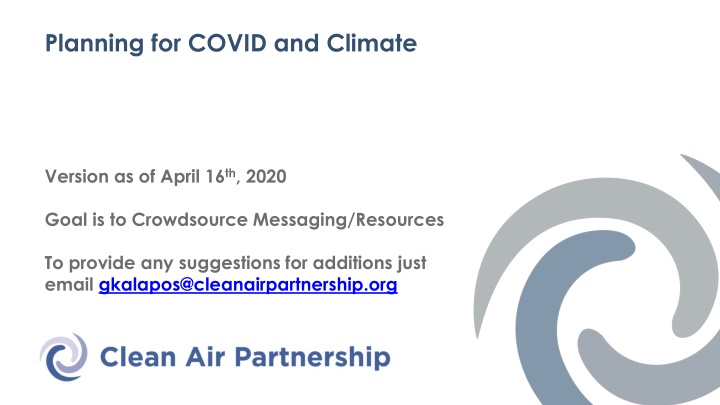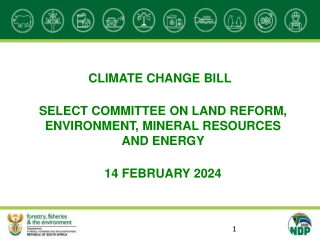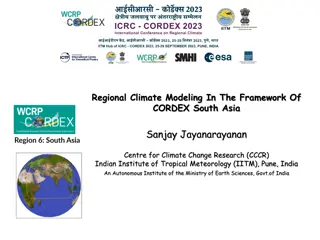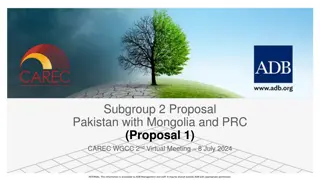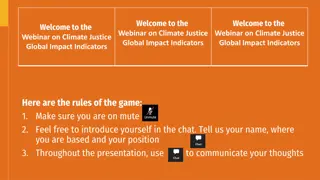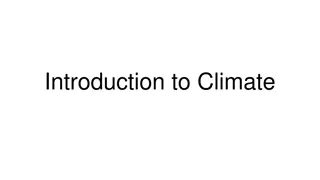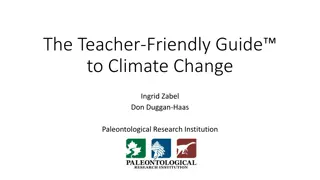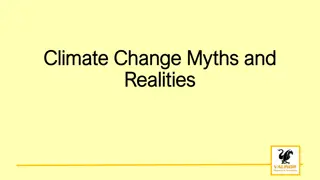COVID and Climate: Acting Together
COVID and climate change are interconnected challenges that require collective action. The response to COVID is a short sprint, while addressing climate change is a long-term marathon. Understanding the link between the two crises is essential in creating a sustainable and resilient future. Learn how individual actions, business initiatives, and government policies play a vital role in mitigating risks and building a healthier society.
Download Presentation

Please find below an Image/Link to download the presentation.
The content on the website is provided AS IS for your information and personal use only. It may not be sold, licensed, or shared on other websites without obtaining consent from the author.If you encounter any issues during the download, it is possible that the publisher has removed the file from their server.
You are allowed to download the files provided on this website for personal or commercial use, subject to the condition that they are used lawfully. All files are the property of their respective owners.
The content on the website is provided AS IS for your information and personal use only. It may not be sold, licensed, or shared on other websites without obtaining consent from the author.
E N D
Presentation Transcript
Planning for COVID and Climate Version as of April 16th, 2020 Goal is to Crowdsource Messaging/Resources To provide any suggestions for additions just email gkalapos@cleanairpartnership.org
Aligning COVID response to Climate Change COVID is an immediate threat. Has health implications for about 15% of the population. Actions undertaken by all individuals will have an impact on determining the death rate of those 15% of people that experience serious health impacts from COVID. To protect those people all need to play a role in influencing how much of the population is exposed to that risk by how much they play a role in spreading COVID. COVID is our Sprint. Climate Change is our longer term threat. It is our Marathon. How well we enable our response to this COVID sprint to be aligned with our climate, low carbon economy, and equity goals will impact how well prepared we are to run our climate marathon.
COVID and Climate Connection COVID is a climate practice run. We have an immediate threat to our survival. Varied death rate of COVID (overwhelming the health care system or versus flu) is an analogy for the difference between 1. 5 and 2 or 3 or 4 degree increase in average temperatures. Small differences make a huge difference when large populations are impacted. Equity has a huge impact on exposure, impacts, outcomes. For solutions to work .. Each one of us can and needs to practice behaviours that mitigate our risks and others risks The choices each one of us makes will determine the heath threats we all will face We need science and results to understand our threats, and to know what we can do about it Individual actions matter, but individuals cannot do it alone Business actions matter, but business cannot do alone We need governments to set the collective structures in place that allow, enable, and ensure the actions undertaken by individuals, business and all sectors of society put what science says works to reduce health impacts into action. It wont work without collective and aligned action.
COVID and Climate Connection Infectious outbreaks could become more common as climate change forces animals and humans into closer proximity. Permafrost melting, pathogen release Bob McDonald, COVID 19 vulnerability, COVID- and climate and more Bill McKibben, What can coronavirus efforts teach us in the fight against climate change?
Air Pollution Air pollution heath impacts increase our heath risks from COVID https://www.theguardian.com/environment/2020/apr/07/air-pollution- linked-to-far-higher-COVID-19-death-rates-study-finds Reducing people s exposure to air pollution in the short term during COVID crisis transportation emissions reductions achieved How to ensure that as things return to pre-COVID levels of service but COVID still poses of threat of recurrence? Reducing people s exposure to air pollution in the longer term for longer term public health benefits. Air pollution exposure kills. Nearly 800,000 people die prematurely each year in Europe because of dirty air, and each life is cut short by an average of more than two years. https://academic.oup.com/eurheartj/article/40/20/1590/5372326
COVID Immediate Response Physical Distancing Physical Distancing (more space between people within our communities) Modes of transportation that allow for more physical distancing (making more room for those walking/cycling to maintain physical distancing) Reallocating road space to people to maintain physical distancing Modes of working that enable more physical distancing (telecommuting) Modes of working that protect jobs (work sharing/shifts) What other synergies are there between climate actions that can support our physical distancing?
What can be done to make public transportation more safe? COVID presents a significant risk to transit ridership over the shorter term Shorter term changes can lead to longer term modal shift Physical distancing; contact tracing; notifications of exposure How to respond to these challenges? Active transportation and micro-mobility for shorter trips What are the leading practices from other jurisdictions to reduce/manage risk?
Food Security Urban Agriculture Plans How do they advance resilience to COVID food insecurity risk. How would we put the actions in a place that takes COVID into consideration. How to manage community gardens to enable their use while ensuring COVID measures are adhered to.
Inequality COVID is exposing stark socio-economic inequalities Will likely exacerbate them Financial risk re loss of employment Personal distancing limitations Increased exposure to COVID in employment Climate change will have differential impacts on geographies and populations and also exposes stark socio-economic inequalities US News (April 1, 2020) Why We Can't Ignore the Link Between COVID-19, Climate Change and Inequity
Actual Examples of Climate Actions that Help with our Immediate COVID Response
Actual Examples to Show Opportunities New Zealand First Country To Fund Pop-Up Bike Lanes, Widened Sidewalks During Lockdown Multiple Cities: NACTO Link: Transit fare suspension. Over 45 cities including New Orleans, New York, Waterloo, Halifax, etc. Some or all of transit services are offered free of charge. Montgomery County, Maryland use of vehicle s rear doors. Seattle ceased fare collections on transit Barcelona, Public Transit Prevention Measures City of London, Ontario: Bike Giveaway City of London, ON closes streets/bridges to cars to give cyclists & pedestrians more space
Actual Examples to Show Opportunities Bike Share Supports from NACTO City Transportation Action Updates (go to chart) Calgary to reduce lanes on some roads to help walkers, cyclists keep their distance during COVID Edmonton making more room for pedestrians on two roads, eliminating beg buttons at 56 intersections FirstOntario Centre transformed into surge shelter for homeless Hamilton residents during COVID-19 pandemic Montreal closing streets to cars, but increasing policing to enforce physical distancing
Actual Examples to Show Opportunities Toronto Public Library partners with local food banks to set up food bank distribution from library branches Mapping How Cities Are Reclaiming Street Space The COVID-19 outbreak and implications to sustainable urban mobility some observations Bike Share and Services as an Essential Service
Summary of COVID/Climate Connections We can tackle monumental challenges: A key lesson from COVID is we can muster society, the policies, and the financial resources to quickly address problems of significant importance. Timing Matters: With COVID-19, quick action by health and governmental officials on COVID has made a huge difference. The longer we wait to mitigate and prepare for the climate emergency, the more it will cost us both in lives and livelihoods. Crises highlight injustices in society: COVID-19 is shining a light on the health, economic, societal, and racial inequities embedded in our society. Preparation Matters: Countries like South Korea that were prepared with good public health systems and pandemic-trained professionals ready with testing, protection, and treatment equipment and supplies, have had much lower COVID-19 incidence and much quicker recovery than we ve had. We must prepare for climate change with similar mastery. Science and Facts Matter: Trust in experts and science has been critical for the successes in COVID-19 response and public welfare. We need our society and leaders to understand the importance of science, facts and climate realities; the existential threats and the opportunities. Leadership Matters: We need our leaders to step up and champion the information, plans, and resources to effectively address climate change. Individual actions matter, but can t succeed without systems put in place to ensure all individuals join the effort. Transparency and Honesty Matter
COVID Economic Recovery and Climate Action
How We Advance our COVID Recovery will Influence us for the Next Generation How we choose to help our communities and our economy recover from COVID will influence the direction we move in for the next 10 15 years. Go through each of our climate actions and identify the economic recovery elements of those actions Employment opportunities What can that be done in a qualitative way What can that be done in a quantitative way Who would we need to work with to help enable us to do that?
Transportation Plans & Public Transit How do we make public transit more safe re: COVID Principles: physical distancing Time rescheduling of peak Costs of public transit Other considerations?
Active Transportation and Micro-Mobility How can we provide more physical distancing to better enable people to use active transportation while maintaining physical distancing recommendations? How can micro-mobility help? What unintended consequences might there be that we should aim to address?
Telecommuting Policies over the Longer Term Experience during COVID with management via results based approach rather than baby sitting approach Ability to advance telecommuting options post COVID What are the opportunities and issues that can have an impact over the longer term? What can we do about them Reducing barriers and instituting telecommuting policies and procedures over the longer term What would that look like?
COVID/Climate Mitigation Lens Buildings Building retrofits present a huge economic recovery opportunity How would we quantify that? What would be the value of quantifying that? How can be best communicate the synergies between building retrofits and economic stimulus? Who is working on that? Ex. Efficiency Canada How can we work with them?
Urban Agricultures Plans How can COVID lend support to food security actions? How would it align with our short/medium and longer term COVID strategies?
Climate Adaptation Actions Where is there potential for alignment between plan actions and our COVID response over the short/medium/long term?
Green Space Balance between providing access to space to exercise and for mental health. Ensuring that physical distancing is being practiced How to ensure/enforce? People power needed to make sure it is not having the unintended consequence of too many people using at once. How to make that work best? Longer term appreciation of the value of green space. How to advance that to increase green space in communities overt the longer term?
Waste Management How to ensure that COVID needs and fears do not negate progress made on zero waste efforts? What can be done in the shorter term? Over the longer term?
Economic Development Plans How do we ensure that climate actions are incorporated into COVID economic recovery response? Who should we work with? Climate Action Network facilitating civic society organizations and messages Climate Caucus exploring this from a municipal perspective Specific Ontario message?
Identifying and Addressing COVID Response Actions that Undermine Climate Progress Fossil fuel company bailouts advocacy position? Civic society advancing this message Would be great to get municipalities also communicating the risks and limitations of additional high carbon sector bail outs/subsidies Getting conversation in front of councils. Communications from Clean Air Council Communications directly from Municipal Councils
Possible Processes for Advancing this Work Crowd sourcing resources/actions/thoughts Identifying real world examples of COVID/Climate approaches Working Group to advance exploration and advancement of this overall work. Discussions would be topic focused so that people can self select the topic they would like to contribute to Discussions would be accelerated in order to try and bring thinking into municipal recovery plans Other suggestions for processes and efforts that can support this effort?
Resources CityShare Canada : A real time crowdsourced platform that houses resources, tools, stories on how city builders and residents are responding to COVID C40 has launched a dedicated COVID-19 Portal for cities during this global crisis Climate Caucus Community Action Handbook USDN Climate and Coronavirus Connections Climate and Coronavirus: Compilation of Articles to Help Us Think About the Connections
Resources: Density, Resilience and COVID Will COVID-19 Spell the End of Urban Density? Don t Bet On It. How will coronavirus shape urban life? Lessons from Pandemics: Comparing Urban and Rural Risks
Resources: Green Economic Recovery Climate Interactive: Green Equitable Stimulus Plans EU heads of government, committed to integrating the green transition in the region recovery plan. COVID, Climate and the Clean Economy: Gigatrends Changing the World
Resources: Community Gardens Victoria. BC has assigned Parks staff to start growing vegetable seedlings for residents. North Carolina: COVID-19 FAQ for Community Gardens
Resources: Climate/COVID Communications UK Climate Outreach: Communicating climate change during the coronavirus crisis what the evidence says
Resources: Additional Resources to suggest? Send to gkalapos@cleanairpartnership.org
